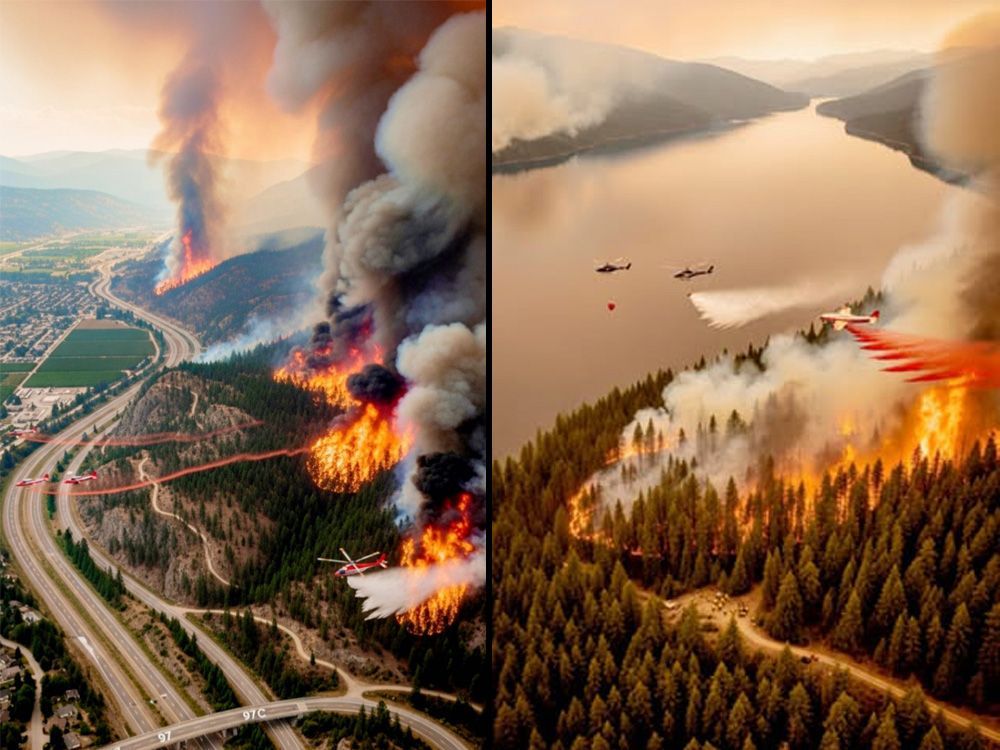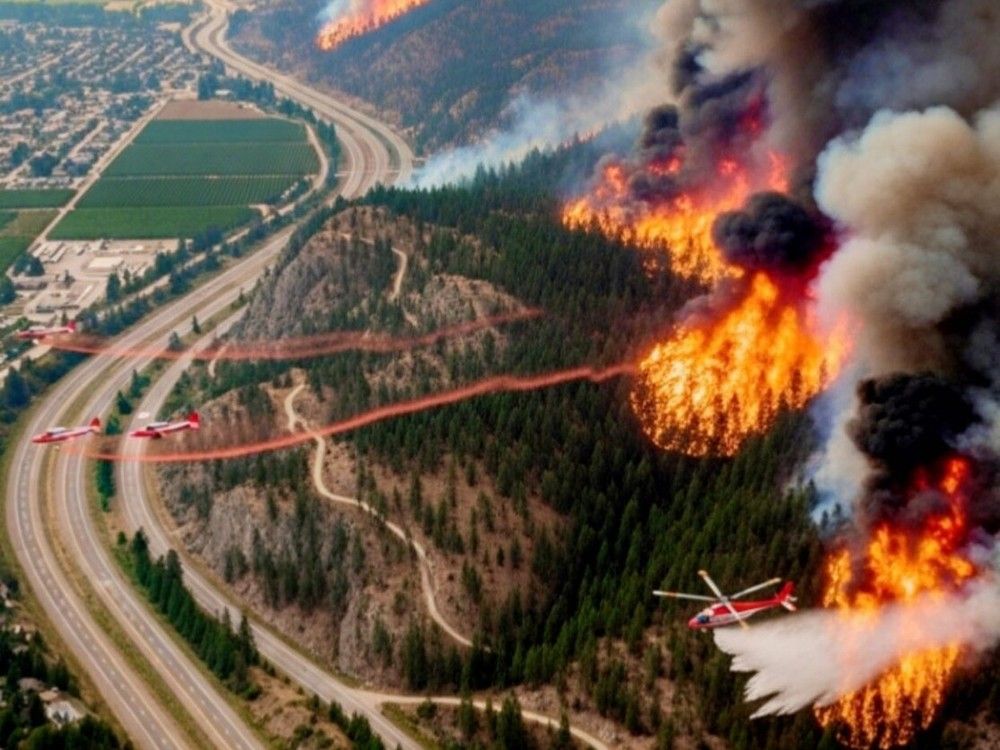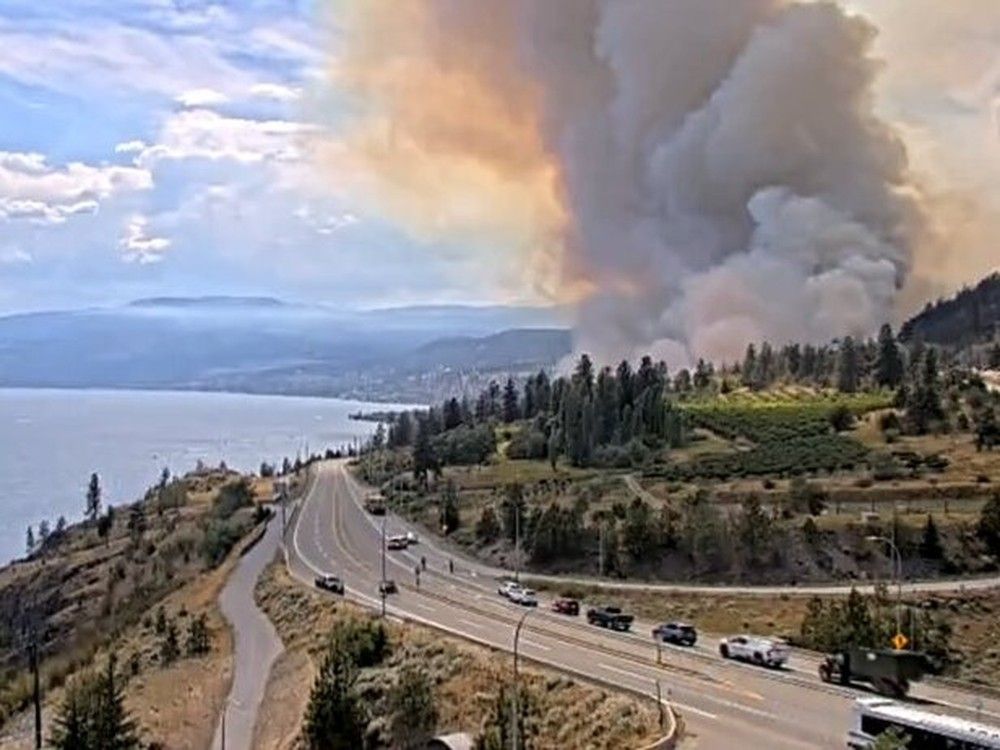
An AI-generated image showing a wall of flames advancing toward an Okanagan highway was shared 239 times on Facebook before the B.C. Wildfire Service drew attention to the fake this week.
The image, which appeared on several social media platforms, accompanied a post about the Drought Hill fire near Peachland by someone called Joemar Sombero, who posts content about fires, earthquakes and other natural phenomenon with AI-generated images that seem intended to inspire awe and dread.
“Whether well-intentioned or intentionally misleading, misinformation is the last thing any of us need during emergencies,” said the B.C. Wildfire Service in its own post, which encouraged the public to seek official sources of wildfire and emergency information and turn a “critical eye to content shared on social media in the heat of the moment.”
It was a smart response to a phenomenon that will only increase as artificial intelligence and social media collide in ways that can have real-life consequences, said Muhammad Abdul-Mageed, the Canada Research Chair in natural language processing and machine learning at the University of B.C.
The professor said that as AI becomes more sophisticated and accessible, it is becoming “really challenging” to detect fake images, particularly if you don’t look closely or understand the technology.
“It seems to me that these images were not generated with a state-of-the-art model,” he said, pointing out the dramatic colours and dimensions, as well as the “incredible angle” of the shot, which shows planes and a helicopter battling the blaze. Someone who is familiar with the Okanagan area would also struggle to recognize the terrain.
Hany Farid, a professor at the University of California, Berkeley, who focuses on digital forensics and misinformation, said someone might post fake images for several reasons, including “simple and unapologetic trolling,” as well as the monetary incentive to create viral content.
“I don’t know exactly why people do this, but it is sadly predictable” he said. “During each natural disaster, we see a spread of fake content, most recently in the Texas floods, and before that in the Southern California wildfires.”
During the Texas floods, an image of a tearful young girl holding a puppy in a rescue boat spread rapidly. News reports said the AI-generated image was being used to prompt people to give to fake charities.
Abdul-Mageed said the person posting content about the Peachland fire might have been doing it “lightheartedly.”
“There are people who like these tools and like to play with these tools, who might not have a level of awareness about the broader issues,” he said.
But he added that the situation also highlights the potential for a more “apocalyptic scenario” where adversaries use an automated process to unleash not just one or two fake images, but thousands, in an orchestrated campaign.
“This can only get worse from here,” he said.
In its response, B.C. Wildfire Service said the AI images “do not accurately represent the terrain, fire size or fire behaviour in the area. Someone scrolling past could believe this image is real or accurate when it is not.”
The wildfire service encouraged people to “identify your own trusted sources” before you need them.


Abdul-Mageed said organizations, such as the government, must be prepared to respond to increasing misinformation. The public also needs to be informed, particularly as it will soon become even more difficult to tell the difference between real and AI-generated images.
“Stop and think. Don’t share,” he said. “Don’t share even to debunk. Report these images to B.C. Wildfire or the proper authorities.”
Farid put it more bluntly: “Nobody in their right mind should be turning to social media for reliable information, and certainly not during an emergency.”
Postmedia was unable to reach Joemar Sombero for comment, but he replied to several people who commented on his post to defend the images.
“The images and write-ups I share are AI-generated for illustrative purposes only and are always tagged with a disclaimer,” he wrote. “My goal is never to sensationalize but to raise awareness about the severity of these events and the impact they have on communities. I understand how important it is to remain sensitive, and I’ll continue to be mindful moving forward. Thank you for holding me accountable.”
In another reply, he said his goal was not to scare anyone, but to keep them informed and prepared.
With 43,000 followers on Facebook, Sombero typically makes several posts per day about disasters and natural phenomenon. While the posts focus on events around the world, a number come from B.C., including a recent post about a bear attack near Creston when a couple out for a bike ride encountered two grizzlies. He has also posted about the Bear Creek wildfire near Harrison Hot Springs, which included another AI-generated fire image without a disclaimer.
The introduction to his Facebook page provides a more general description of Sombero’s purpose: “Sharing random bits of creativity — AI art, nature scenes, and moments that inspire.” He also has an Instagram account.
Many of Sombero’s posts draw attention to climate change, including a recent one that shows the smoke from Canadian wildfires spilling into the United States. The credited satellite image is from the European Space Agency’s Sentinel-3 satellite.
“Canada’s wildfire emissions in June and July were already off the charts — now they’re climbing even higher,” said the post. “This isn’t just a Canadian crisis. It’s a North American emergency.”